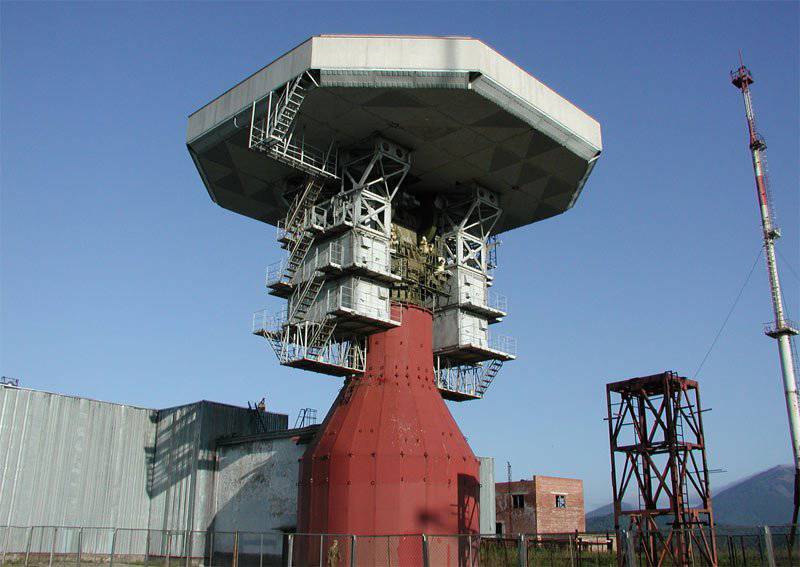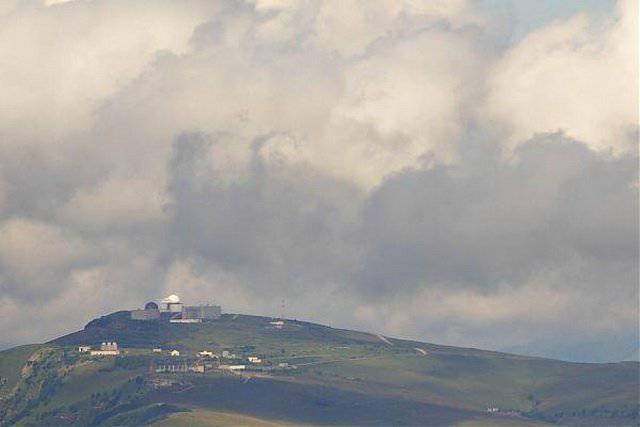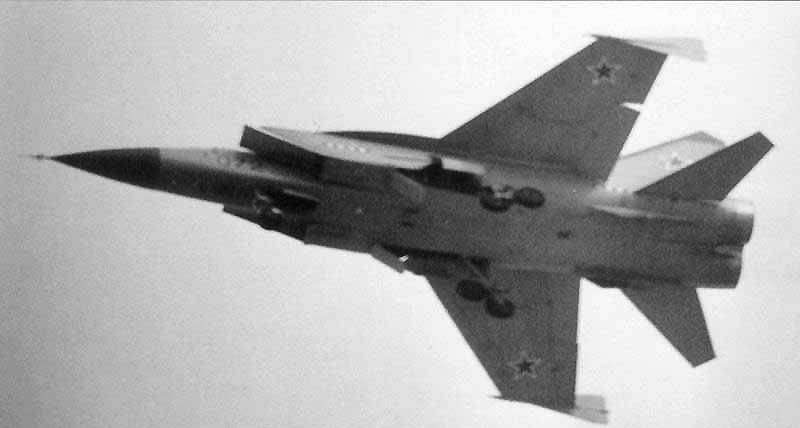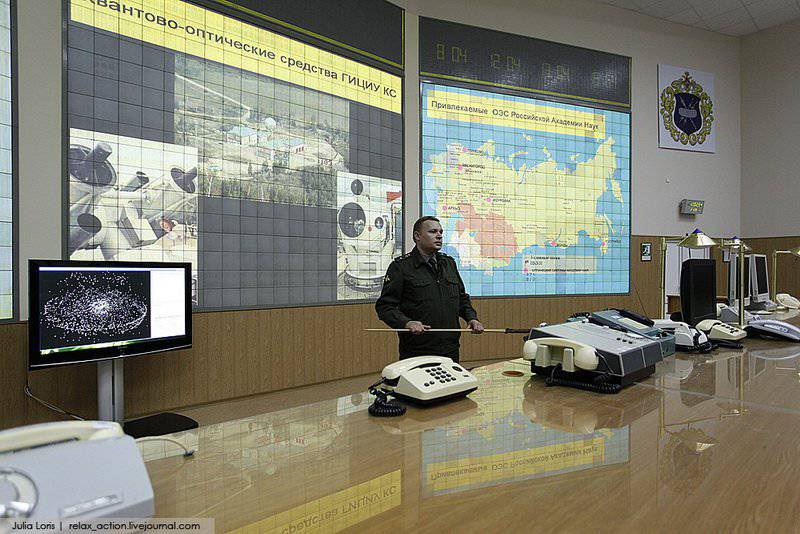The Ministry of Defense will test the Krona antisatellite complex
According to the plans of the Ministry of Defense, the deadlines and plans for testing the upgraded Krona anti-satellite defense complex are scheduled for the end of 2013. It is reported that the main emphasis will be placed on the interaction of various components, especially percussion aids, with ground-based ROK — a radar-optical complex for searching and identifying space targets. It is reported that the radars of the complex, which still have the old Soviet index 45Ж6, were released in 1980-ies, but during 2009-2010 the state tests were modernized and passed. According to the officers of the General Staff, they have no complaints about ROC itself.
The Krona Radio Optical Space Recognition Complex is an object of the space monitoring system, which includes 2 operating systems: radio-band and optical, it is part of the Russian Space Defense Forces. This complex monitors outer space using observations both in the active (laser location) and in the passive mode. After computer processing, the data received by him are transferred to the CCC, the Center for Control of Outer Space.

The work on the creation of the Krona ROCR KO was started in accordance with the resolution of the USSR Government of November 1984. The construction of the facility was carried out by the Scientific Research Institute of Industrial Design and JSC NPK NIIDAR. The beginning of work on its creation was in the Soviet era, but the restructuring that had begun and the collapse of the country slowed them down significantly. In the 1994, the object was tested on the test-experimental work, and in 2000, the complex finally got up to combat duty. In 2010, it was upgraded, during which it received a high-precision radar channel "H", designed to determine the position and recognition of targets in Earth’s orbit.
The radar-optical complex for the recognition of space objects 45Ж6 “Krona” is intended for the recognition of various military space objects, as well as information and ballistic support of the anti-space defense actions and active anti-missile defense systems of the country. The complex initially included:
- the radio part of the 40Ж6 complex with 20Ж6 radar, which has 2 main channels of operation: channel "A" is intended for detecting artificial Earth satellites and channel "H", intended for extremely accurate angular measurements of parameters of artificial Earth satellites;
20ZH radar can operate in decimeter (channel "A") and centimeter (channel "H") ranges. The radar is able to detect a target deleted by 3500 km.
Channel “A” is a receiving-transmitting antenna array with an aperture of size 20 × 20 m and electron beam scanning, phased antenna array (PAR). Channel “H” is a receiving-transmitting system consisting of 5 rotating parabolic antennas that operate on the principle of an interferometer, due to which they make it possible to accurately measure the orbital elements of space objects.
- Optical means of the system consist of a laser-optical locator (LOL) "30Ж6" (from 2005 year), which includes: receiving and receiving-transmitting channels, Passive channel autonomous detection (CAO) of space objects, which patrols with search for previously unknown space objects.
- command and computing center equipped with the 13K6 computer complex with the 40Х6 computer (as far back as Soviet times).

The capabilities of the Krona complex in determining the coordinates of space objects made it possible to use it as a means of targeting anti-space defense systems. In the USSR, it was planned to build an 3-like complex, which should have covered the entire southern border of the country. The only operating complex is currently located on the territory of Karachay-Cherkessia at the top and in the vicinity of Mount Chapal.
The entire system of ROCK “Krona” functions in the interaction of all 3-x channels: this is how channel “A” of the radar locates a space object and measures its orbital characteristics, with the use of which channel “H” is guided to a given point and carries out its work. At the same time, according to the trajectory data of channel “A”, the optical passive or active channel, which collects its information about the detected object, starts its work. As a result of this interaction, it is possible to significantly improve the accuracy and detail of information about the detected space object. At the same time, the throughput of the entire complex is estimated at the level of the order of 30 000 objects per day.
Since the anti-satellite system was designed not only for the detection of space objects, but also for their destruction, an anti-satellite system was included in its composition aviation 30P6 Kontakt complex consisting of: MiG-31D carrier aircraft and 79M6 Kontakt interceptor missile, which had a kinetic warhead. Before its collapse, the Soviet defense industry was able to modernize 3 supersonic high-altitude interceptors MiG-31, which were entrusted with the task of delivering anti-satellite missiles to the upper atmosphere. Such aircraft received an additional letter "D" in the name. All 3 MiG-31Ds made in the USSR in the early 1990s were sent to the Sary-Shagan Kazakh training ground, where they remained subsequently. There is still no official data that tests of the 79M6 Kontakt interceptor missile were conducted in the USSR.

The remaining MiG-XNUMHD fighters on the territory of Kazakhstan first tried to use them for commercial purposes, trying to adapt them for launching small space rockets. However, the Kazakh project ended in failure, and now these planes are just dead. The revival of the large-scale anti-satellite defense project began only after 31 years after the collapse of the USSR. In 18, the then commander-in-chief of the Russian Air Force, Colonel-General Alexander Zelin, said that the anti-space defense system based on the MiG-2009 interceptor fighter would be reanimated to solve the same tasks.
If there are at least some information about the ground components of the Krona complex that can be easily found on the Internet, then its air component is classified much more strongly. At present, it is only known that the creation of a new anti-satellite rocket, which should replace the "Contact", is carried out by the Fakel design bureau, located in Khimki near Moscow. The same design bureau specializes in the development of rocket and space technologies, but it refused to inform journalists about new products for Krona. Along with this, there is no information on the modernization of the new batch of MiG-31 supersonic interceptor fighters, which will have to be replaced by planes lost in Kazakhstan. At the same time, Izvestia sources in the military-industrial complex say that bringing the aircraft to modification “D” does not constitute any particular problems.
With such an aircraft, all suspension and mounting assemblies are removed, the on-board radar, the radio transparent cap is changed to a metal one. At the ends of the wings of the fighter for a more stable flight with a vertical climb established special aerodynamic influxes, which are called "flippers". They are also used to stabilize the flight of the MiG-31 with the antimissile system suspended under the fuselage, since it has a large mass and dimensions, and the area of the wing of the aircraft does not allow for stable flight with it. After that, a new communications complex and an aiming complex are installed on the aircraft.

The Russian Defense Ministry explained that the upcoming tests will verify the possibility of issuing target designation of strike aircraft from the ground, as well as the interaction between the air and ground components of the Krona. At the same time, at the initial stage, instead of the MiG-XNUMHD, the usual MiG-31 from the Russian Air Force will work out. MilitaryRussia website editor and military expert Dmitry Kornev believes that the algorithms and logic of combat work, ground equipment can be used and what was created back in 31-1980-s.
At the same time, the rocket will most likely need a new one, which will be created by the forces of the same design bureau Fakel, Novator, Vympel. However, he did not rule out the reorientation of the entire system, for example, to ground-based missiles. In the event that the Krona is really equipped with ground-based missiles, it becomes clear why the air component of the anti-satellite complex is so secret. In this case, it simply does not exist and never will.
Information sources:
- http://izvestia.ru/news/543550
- http://old.redstar.ru/2010/09/29_09/2_01.html
- http://militaryrussia.ru/blog/topic-699.html
- http://ru.wikipedia.org
Information